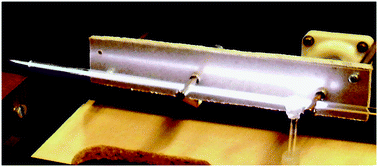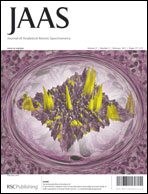A 13.56 MHz plasma jet discharge, called a plasma pencil, was investigated. Rotational and excitation temperatures, and electron number densities for the pencil under and without sample load were calculated using OH band spectra, Ar lines and Hβ line, respectively. The rotational temperatures were found to be relatively low at about 800 K, however, excitation temperatures exceeded 4000 K. The plasma was found to be strongly non-isothermal. Some atomic lines of elements were easily observed. Aqueous solution-based aerosols were incorporated into the plasma without desolvation. Standard water solutions of the elements were nebulized into the plasma. The Ar carrier gas and Ar plasma gas flow rates were 0.3 and 4.0 l min−1, respectively. The forwarded power was 140 W. Intensities of the atomic lines, temperatures and electron number densities along the discharge tube were acquired in different positions from the aerosol entrance and an optimal position providing the best signal-to-noise ratio for each line intensity was established. Calibration dependencies for Ca, Cu, Mg, Zn, Li, Na were measured in the rage of 1–100 mg l−1. 3-sigma detection limits in the best observation axial position were (μg l−1): 27 (Ca), 49 (Cu), 58 (Mg), 40 (Li), 13 (Na) and 180 (Zn).


 Please wait while we load your content...
Please wait while we load your content...